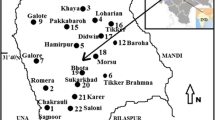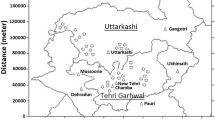Abstract
Indoor radon and thoron concentrations in the domestic environment result in natural radiation exposure to the public due to the inhalation of their short-lived decay products. Keeping this in view, the annual effective dose and other radiation risks due to radon/thoron progenies have been calculated. In this study, newly developed time deposition-based progeny sensors (DTPS/DRPS) were used for long-term passive determination of progeny concentrations in the environment of Jammu and Kashmir, Himalayas, India. The total equilibrium equivalent radon (EECRA + U) and thoron (EECTA + U) concentrations (“A” and “U” referring to attached and unattached fractions) were found to vary from 5 to 38 Bq m−3 with an average value of 18 Bq m−3 and from 0.48 to 5.49 Bq m−3 with an average value of 1.69 Bq m−3, respectively. The aerosol concentration, equilibrium factors, and unattached fractions for radon and thoron progeny have been estimated in normal living conditions and their dependence on each others have also been studied. The annual equilibrium factor for radon and thoron progeny has been determined from the calculated data. The estimated annual effective dose due to radon progeny (0.34 to 2.42 mSv y−1) and thoron progeny (0.13 to 1.54 mSv y−1) is found to be below the world’s recommended level. Based on measurements of mean values of the unattached fraction, dose conversion factors (DCFs) in units of mSv per working level month (WLM) has been calculated and the average calculated values of DCFs are 24, 10, and 13 mSv WLM−1. The variability of equilibrium factor and radon/thoron progeny with different seasons, ventilation conditions, and types of houses were also analyzed.











Similar content being viewed by others
References
Bangotra R, Mehra R, Kaur K, Kanse S, Mishra R, Sahoo BK (2015) Estimation of EEC, unattached fraction and equilibrium factor for the assessment of radiological dose using pin-hole cup dosimeters and deposition based progeny sensors. J Environ Radioact 148:67–73. https://doi.org/10.1016/j.jenvrad.2015.06.010
Bennett WD, Zeman KL, Jarabek AM (2003) Nasal contribution to breathing with exercise: effect of race and gender. J Appl Physiol 95(2):497–503. https://doi.org/10.1152/japplphysiol.00718.2002
Charles MW (2007) Radon exposure of the skin: I. Biological effects. J Radiol Prot 27(3):231–252. https://doi.org/10.1088/0952-4746/27/3/R01
Guo Q, Lei Z, Lu G (2012) Assessment of the unattached fraction of indoor radon progeny and its contribution to dose: a pilot study in China. J Radiol Prot 32(4):447–454. https://doi.org/10.1088/0952-4746/32/4/447
Gupta RD, Verma SD (1975) Studies on soil of Udhampur districts of Jammu & Kashmir in relation to parent material, climate and vegetation, Part 1—Morphology and physic-chemical characteristics. Fertil Technol 12(3):231–236
Hopke PK (1992) Some thoughts on the unattached fraction of radon decay products. Health Phys 63(2):209–212. https://doi.org/10.1097/00004032-199208000-00010
Hopke PK, Jensen B, Li CS, Montassier N, Wasiolek P, Cavallo A, Gatsby K, Socolow R, James AC (1995) Assessment of the exposure to and dose from radon decay products in normally occupied homes. Environ Sci Technol 19:1359–1364
Huet C, Tymen G, Boulaud D (1999) Size distribution, equilibrium ratio and unattached fraction of radon decay products under typical indoor domestic conditions. Sci Total Environ 272:97–103
ICRP (1993) Protection against radon-222 at homes and at work. ICRP Publication 65 Ann. ICRP: 3(2)
ICRP (2007) The 2007 recommendation of the International Commission on Radiological Protection. ICRP Publication 103
ICRP (International Commission on Radiological Protection) (2010) Lung cancer risk from radon and progeny and statement on radon. ICRP Publication-115, Pergamon Press, Oxford
ICRP (International Commission on Radiological Protection) (2014) Radiological protection against radon exposure. ICRP Publication 126, Annals of the ICRP, 43(3)
Jasaitis D, Girgždys A (2011) Influence of aerosol particle concentration on volumetric activities of indoor radon progeny. Lith J Phy 51(2):155–161. https://doi.org/10.3952/lithjphys.51209
Kaur M, Kumar A, Mehra R, Mishra R (2017a) Dose assessment from exposure to radon, thoron and their progeny concentration in dwellings of sub-mountainous region of Jammu & Kashmir, India. J Radioanal Nucl Chem 315(1):75–88. https://doi.org/10.1007/s10967-017-5632-0
Kaur M, Kumar A, Mehra R, Mishra R (2017b) Assessment of attached and unattached progeny concentrations of 222Rn/220Rn and their contribution to dose using deposition-based progeny sensors. Environ Earth Sci 76(16). https://doi.org/10.1007/s12665-017-6874-4
Knutson EO (1988) Modeling indoor concentrations of radon’s decay products. In: Nazaroff WW, Nero AV Jr (eds) Radon and its decay products in indoor air. Wiley, New York, pp 161–199
Kojima H, Abe S (1988) Measurements of the total and unattached radon daughters in a house. Radiat Prot Dosim 24(1-4):241–244. https://doi.org/10.1093/oxfordjournals.rpd.a080278
Kumar A, Chauhan RP (2014) Measurement of indoor radon–thoron concentration and radon soil gas in some north Indian dwellings. J Geochem Explor 143:155–162. https://doi.org/10.1016/j.gexplo.2014.04.006
Kumar A, Sharma S, Mehra R, Kanwar P, Mishra R, Kaur I (2017) Assessment of radon concentration and heavy metal contamination in groundwater of Udhampur district, Jammu & Kashmir, India. Environ Geochem Health. https://doi.org/10.1007/s10653-017-0027-2
Marsh JW, Birchall A (2000) Sensitivity analysis of the weighted equivalent lung dose per unit exposure from radon progeny. Radiat Prot Dosim 87(3):167–178. https://doi.org/10.1093/oxfordjournals.rpd.a032993
Marsh JW, Harrison JD, Laurier D, Blanchardon E, Paquet F, Tirmarche M (2010) Dose conversion factors for radon: recent developments. Health Phys 99(4):511–516. https://doi.org/10.1097/HP.0b013e3181d6bc19
Mayya YS, Eappen EP, Nambi KSV (1998) Methodology for mixed field inhalation dosimetry in monazite areas using a twin-cup dosimeter with three track detectors. Radiat Prot Dosim 77(3):177–184. https://doi.org/10.1093/oxfordjournals.rpd.a032308
Mayya YS, Mishra R, Prajith R, Sapra BK, Kushwaha HS (2010) Wire-mesh capped deposition sensors: novel passive tool for coarse fraction flux estimation of radon thoron progeny in indoor environments. Sci Total Environ 409(2):378–383. https://doi.org/10.1016/j.scitotenv.2010.10.007
Mehra R, Jakhu R, Bangotra P, Kaur K, Mittal HM (2016) Assessment of inhalation dose from the indoor 222Rn and 220Rn using RAD7 and pinhole cup dosemeters. Radiat Prot Dosim 178:208–211
Mishra R, Mayya YS (2008) Study of a deposition-based direct thoron progeny sensor (DTPS) technique for estimating equilibrium equivalent thoron concentration (EETC) in indoor environment. Radiat Meas 43(8):1408–1416. https://doi.org/10.1016/j.radmeas.2008.03.002
Mishra R, Mayya YS, Khushwaha HS (2009) Measurement of 220Rn/222Rn progeny deposition velocities on surfaces and their comparison with theoretical models. Aerosol Sci 40(1):1–15. https://doi.org/10.1016/j.jaerosci.2008.08.001
Nair MK, Nambi KS, Amma NS, Gangadharan P, Jayalekshmi P, Jayadevan S, Cherian V, Reghuram KN (1999) Population study in the high natural background radiation area in Kerala, India. Radiat Res 152:145–148
NRC (National Research Council) (1991) Comparative dosimetry of radon in mines and homes. National Academy Press, Washington, DC
Porstendorfer J (1996) Radon: measurement related dose. Environ Int 1:563–583
Porstendorfer J (2000) Influence of physical parameters on doses from radon exposures. Int Congr Ser 1225:149–160
Porstendorfer J (2001) Physical parameters and dose factors of the radon and thoron decay products. Radiat Prot Dosim 94(4):365–373. https://doi.org/10.1093/oxfordjournals.rpd.a006512
Prasad M, Rawat M, Dangwal A, Kandari T, Gusain GS, Mishra R, Ramola RC (2016) Variability of radon and thoron equilibrium factors in indoor environment of Garhwal Himalaya. J Environ Radioact 151:238–243. https://doi.org/10.1016/j.jenvrad.2015.10.017
Ramamurthi M, Hopke PK (1989) On improving the validity of wire screen unattached fraction of 222Rn daughter measurements. Health Phys 56(2):189–194. https://doi.org/10.1097/00004032-198902000-00006
Ramola RC, Prasad M, Kandari T, Pant P, Bossew P, Mishra R, Tokonami S (2016) Dose estimation derived from the exposure to radon, thoron and their progeny in the indoor environment. Sci Rep 6(1). https://doi.org/10.1038/srep31061
Reineking A, Porstendorfer J (1990) “Unattached” fraction of short-lived Rn decay products in indoor and outdoor environments: an improved single-screen method and results. Health Phys 58(6):715–727. https://doi.org/10.1097/00004032-199006000-00003
Reineking A, Becker KH, Porstendörfer J (1985) Measurements of the unattached fractions of radon daughters in houses. Sci Total Environ 45:261–270. https://doi.org/10.1016/0048-9697(85)90227-X
Sahoo BK, Sapra BK (2015) Advances in measurement of indoor 222Rn and 220Rn gas concentrations using solid state nuclear track detectors. Solid State Phenom 238:116–126. https://doi.org/10.4028/www.scientific.net/SSP.238.116
Sahoo BK, Sapra BK, Kanse SD, Gaware JJ, Mayya YS (2013) A new pin hole discriminated 222Rn/220Rn passive measurement device with single entry face. Radiat Meas 58:52–60. https://doi.org/10.1016/j.radmeas.2013.08.003
Singh P, Singh P, Singh S, Sahoo BK, Sapra BK, Bajwa BS (2015) A study of indoor radon, thoron and progeny measurement in Tosham region Haryara, India. J Radiat Res Appl Sci 8(2):226–233. https://doi.org/10.1016/j.jrras.2015.01.008
Singh P, Saini K, Mishra R, Sahoo BK, Bajwa BS (2016) Attached, unattached fraction of progeny concentrations and equilibrium factor for dose assessments from 222Rn and 220Rn. Radiat Environ Biophys 55(3):401–410. https://doi.org/10.1007/s00411-016-0656-3
Steinhausler F, Hofmann W, Lettner H (1994) Thoron exposure of man: a negligible issue? Radiat Prot Dosim 56(1-4):127–131. https://doi.org/10.1093/oxfordjournals.rpd.a082436
United Nations Scientific Committee on the Effects of Atomic Radiation (UNSCEAR) (1993) Sources and effects of ionizing radiation (New York: United Nations)
UNSCEAR (2006) Sources and effects of ionizing radiation (report to general assembly with scientific annexes. United Nations, New York)
UNSCEAR (2008) United Nations Scientific Committee on the Effect of Atomic Radiation, Report to the General Assembly. United Nation, New York
UNSCEAR (2009) United Scientific Committee on the Effects of Atomic radiation. UNSCEAR 2006 Report: Annex E: Source-to-effects assessment 1075 for radon in homes and workplaces. New York: United Nations, 2009
UNSCEAR (United Nations Scientific Committee on the Effects of Atomic Radiation) (2000) Annex B: Exposures from natural radiation sources. United Nations, New York, p 104
WHO (2009) Handbook on indoor radon. A public health perspective. Whqlibdoc.who.int/publications/2009/9789241547673_eng.pdf
Acknowledgements
We express our appreciation to DAV College Amritsar for providing essential facilities to this work. Furthermore, the inhabitants of the study area are highly appreciated for their kind support amid field work.
Funding
The authors are grateful to the Board of Research in Nuclear Science (BRNS), Department of Atomic Energy, (DAE-BRNS, sanction no. 2013/36/60 BRNS), for providing financial assistance for this work.
Author information
Authors and Affiliations
Corresponding author
Additional information
Responsible editor: Georg Steinhauser
Rights and permissions
About this article
Cite this article
Sharma, S., Kumar, A., Mehra, R. et al. Assessment of progeny concentrations of 222Rn/220Rn and their related doses using deposition-based direct progeny sensors. Environ Sci Pollut Res 25, 11440–11453 (2018). https://doi.org/10.1007/s11356-018-1414-7
Received:
Accepted:
Published:
Issue Date:
DOI: https://doi.org/10.1007/s11356-018-1414-7




